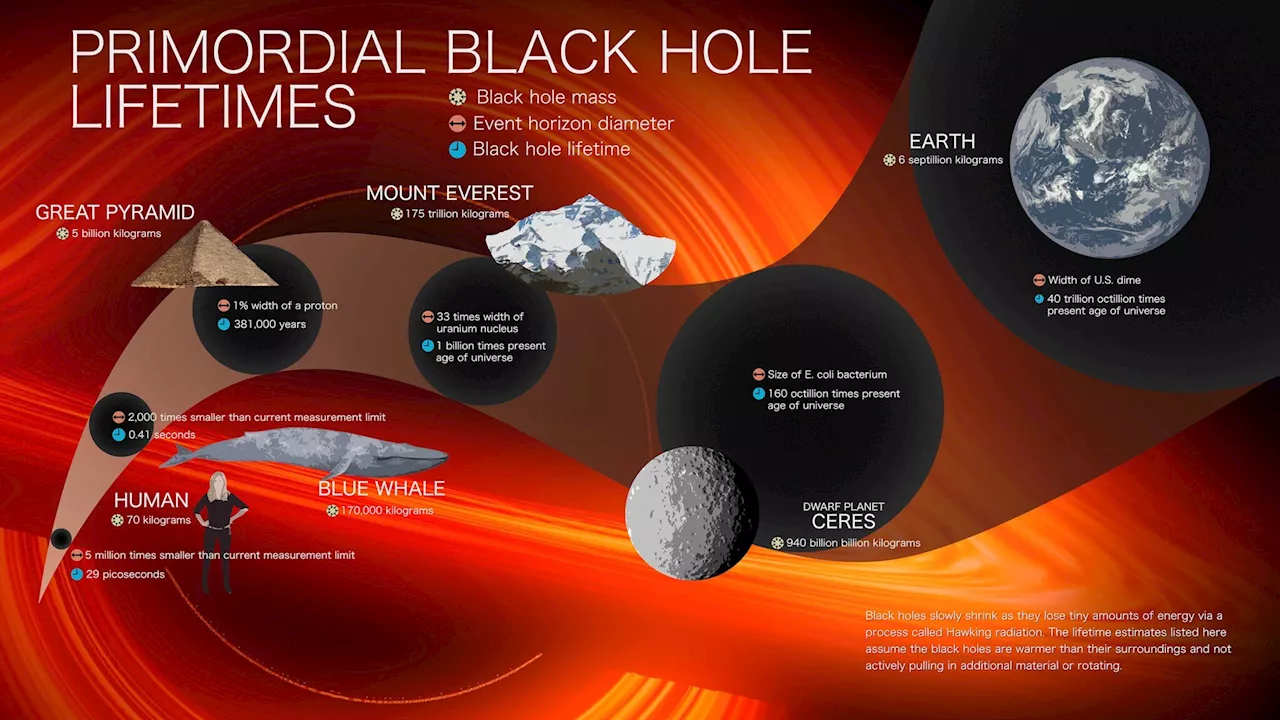Astronomers have discovered black holes ranging from a few times the Sun’s mass to tens of billions. Now a group of scientists has predicted that NASA’s Nancy
Grace Roman Space Telescope could find a class of “featherweight” black holes that has so far eluded detection.
But there’s a minimum mass required: at least eight times that of our Sun. Lighter stars will either become Stephen Hawking theorized that black holes can slowly shrink as radiation escapes. The slow leak of what’s now known as Hawking radiation would, over time, cause the black hole to simply evaporate. This infographic shows the estimated lifetimes and event horizon –– the point past which infalling objects can’t escape a black hole’s gravitational grip –– diameters for black holes of various small masses.Observations have already revealed clues that such objects may be lurking in our galaxy.
“There’s no way to tell between Earth-mass black holes and rogue planets on a case-by-case basis,” DeRocco said. But scientists expect Roman to find 10 times as many objects in this mass range than ground-based telescopes. “Roman will be extremely powerful in differentiating between the two statistically.”
Black Holes Dark Matter Galaxies Stars & Black Holes Galaxies Stars & Black Holes Research General Goddard Space Flight Center Missions Nancy Grace Roman Space Telescope Origin & Evolution Of The Universe Science & Research The Big Bang The Universe
United States Latest News, United States Headlines
Similar News:You can also read news stories similar to this one that we have collected from other news sources.
 How NASA's Roman mission will hunt for primordial black holesAstronomers have discovered black holes ranging from a few times the sun's mass to tens of billions. Now a group of scientists has predicted that NASA's Nancy Grace Roman Space Telescope could find a class of 'featherweight' black holes that has so far eluded detection.
How NASA's Roman mission will hunt for primordial black holesAstronomers have discovered black holes ranging from a few times the sun's mass to tens of billions. Now a group of scientists has predicted that NASA's Nancy Grace Roman Space Telescope could find a class of 'featherweight' black holes that has so far eluded detection.
Read more »
 New public-art piece from Mission Ballroom’s disco-ball designer will make you say “Whee”“Whee” is fully interactive; just grab the metal bar at the base, give it a good spin, and the work’s organic energy begins to flow.
New public-art piece from Mission Ballroom’s disco-ball designer will make you say “Whee”“Whee” is fully interactive; just grab the metal bar at the base, give it a good spin, and the work’s organic energy begins to flow.
Read more »
 ESA's Gaia mission discovers the biggest stellar black hole in our galaxy yetMariella Moon has been a night editor for Engadget since 2013, covering everything from consumer technology and video games to strange little robots that could operate on the human body from the inside one day. She has a special affinity for space, its technologies and its mysteries, though, and has interviewed astronauts for Engadget.
ESA's Gaia mission discovers the biggest stellar black hole in our galaxy yetMariella Moon has been a night editor for Engadget since 2013, covering everything from consumer technology and video games to strange little robots that could operate on the human body from the inside one day. She has a special affinity for space, its technologies and its mysteries, though, and has interviewed astronauts for Engadget.
Read more »
 Small-town star Roman Voss picks up Gophers offerMinnesota is the first division one school to offer Jackson, Minnesota's Roman Voss
Small-town star Roman Voss picks up Gophers offerMinnesota is the first division one school to offer Jackson, Minnesota's Roman Voss
Read more »
 1,900-year-old Roman legionary fortress unearthed next to UK cathedralJennifer Nalewicki is a Salt Lake City-based journalist whose work has been featured in The New York Times, Smithsonian Magazine, Scientific American, Popular Mechanics and more. She covers several science topics from planet Earth to paleontology and archaeology to health and culture. Prior to freelancing, Jennifer held an Editor role at Time Inc.
1,900-year-old Roman legionary fortress unearthed next to UK cathedralJennifer Nalewicki is a Salt Lake City-based journalist whose work has been featured in The New York Times, Smithsonian Magazine, Scientific American, Popular Mechanics and more. She covers several science topics from planet Earth to paleontology and archaeology to health and culture. Prior to freelancing, Jennifer held an Editor role at Time Inc.
Read more »
 Rare Roman Dodecahedron Found in England Baffles ArchaeologistsThe Best in Science News and Amazing Breakthroughs
Rare Roman Dodecahedron Found in England Baffles ArchaeologistsThe Best in Science News and Amazing Breakthroughs
Read more »
